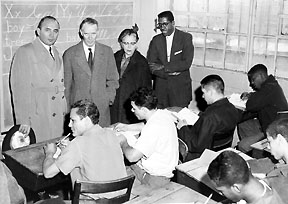| '600' School Established for Adolescents at Rikers Island
The present administration [1959], under the aegis of the Commissioner [Anna M. Kross], had struggled for five years to provide education to the sentenced youth whose schooling had been interrupted by incarceration. In setting up the original school for adolescents at Rikers Island, the department found itself unable to attract qualified teaching personnel due to the isolated island penal setting and the fact that career and salary inducements in the budget lines of the department were not as attractive as offered by the Board of Education. Correction officer personnel with teaching backgrounds were utilized to make up the deficiencies in staff. The original school building was set up in an improvised storehouse renovated to accommodate eleven classrooms.
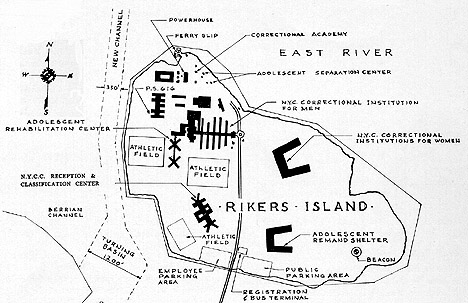
|
|
The above map appeared in Commissioner Kross' 1963 annual report. Note jail now known as JATC is labeled "N.Y.C. Correctional Institution for Men." P.S. 616, situated behind it, is below and to the left of the "Powerhouse" at the top of the map.
|
The establishment of P.S. 616, Bronx, at the New York City Correctional Institution on Rikers Island, under the auspices of the N.Y.C. Board of Education on September 9, 1959, therefore marked a milestone in the history and aims of the Department of Correction.
Typical of the cooperative efforts which helped to bring about the creation of the school is the assignment of two Correction employees to serve as members of the teaching staff until licensed teachers are selected and induced to work in a penal setting. The rehabilitation program of the Department of Correction is also available to the school. Psychological testing is given by staff members of the Department of Correction including an intensive program of psychotherapy.
Superintendent of Schools, John J. Theobald, Board of Education, is to be commended for the efficient organization of the new school and his readiness to accept this long overlooked responsibility.
The members of the Education Advisory Committee, who were organized by the Commissioner to study the problem, deserve just recognition for their part in lending support to the concept that this project was a responsibility of the Board of Education. The Committee is comprised of the following outstanding educators:
- Frances Kohan, Chairman;
- Dr. Frederick Pertsch, Associate Superintendent, Board of Education;
- Dr. Morris Krugman, Assistant Superintendent, Division of Vocational Guidance, Board of Education;
- Dr. Philip Becker, Assistant Superintendent, Vocational High School Division, Board of Education;
- Dr. May Lazar, Assistant Director, Bureau of Educational Research, Board of Education;
- Mr. Arthur Clinton, Director, Bureau of Attendance, Board of Education;
- Mrs. Betty Hawley Donnelly, Advisory Board for Vocational and Extension Education, Board of Education;
- Dr. Seelig Lester, Principal, Samuel Gompers Vocational High School;
- Mr. Julius Nierow, Deputy Executive Director, N. Y. C. Youth Board;
- Mr. Robert R. Hannum, Director of Vocational Placement of the Osborne Association of N. Y.;
- Mr. Curtis Roosevelt, Regional Director, National Citizen's Council for Better Schools;
- Mrs. Carolyn Green and Miss Anna Altman of the N. Y. S. Employment Service;
- Mr. Fred Kuper, lawyer; and
- Mrs. Sylvia Lane, lawyer.
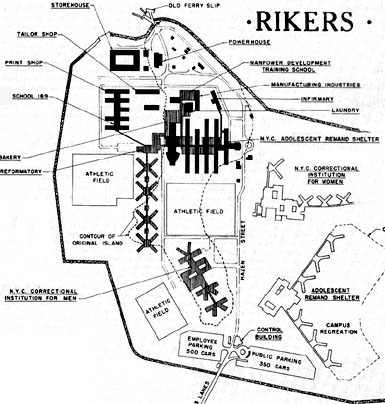
|
|
The map, from which the above section was taken and slightly modified, appeared as the cover of the late 1968 issue of the DOC newsletter, Correction Sidelights, depicting planned and actual facilities on Rikers under Mayor John V. Linday. Note the "NYC Correctional Institution for Men" is no longer the jail now known as JATC but refers to C-76 (now known as EMTC). P.S. 616 has become P.S. 189 but is still located where it was under the "600" school name.
|
The "600" schools, of which there are twenty five are under the direction of Dr. John B. King, Associate Superintendent. They are special schools, initiated in 1947, to meet the needs of troubled children and youths who are unamenable to regular school instruction. In order to expedite the establishment of P. S. 616 on Rikers Island, the Department of Correction transferred $52,610 from its own educational budget to that of the Board of Education to implement the initial staffing of the school. The teaching staff of P. S. 616 now includes ten academic teachers, four industrial education teachers, a school secretary and a principal. All of the teaching personnel are licensed and especially selected for their skill in working with this type of pupil.
The daily sentenced adolescent (16-21) population at Rikers Island averages about 600 inmates. Unfortunately, under existing limited budgetary resources and facilities, only 200 adolescents now attend the school for full time academic and vocational instruction. Since many of the inmate-students present a severe retardation problem, an intensive program of remedial reading and mathematics has been instituted. Admission to the school is determined by the Institutional Classification Board. A representative of the school serves on the Board and assists in screening candidates for admission.
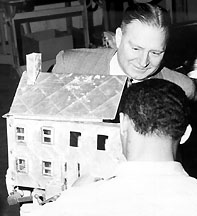
|
|
Superintendent of Schools John Theobald checks a student inmate's work in the P.S. 616 sheet metal shop during a March 22, 1960, visit. [Photo from Correction Archives]
|
Courses offered by the school are: English, social studies, mathematics, science, business training, woodworking, men's tailoring, printing, and metal work. A course in pre-military guidance is offered to a limited number of pupils who meet specified selective criteria. Each youth is given individual counseling and guidance by assigned teachers. To evaluate progress made while attending the school, each pupil is given an achievement test upon entrance and before discharge.
To foster school spirit and to provide wholesome outlets for musical and dramatic talents, a school assembly is held weekly. To increase the pupils' awareness of the responsibilities of decent citizenship, a monthly citizenship topic is assigned for classroom discussion. A recent topic was "If I Could Speak to My Old High School Assembly on Delinquency." The first edition of the school newspaper will be issued shortly carrying articles written by the pupils on similar topics.
An indoor gymnasium and assembly auditorium are being set up through the conversion of a former Department of Correction storage building.
We Look Forward
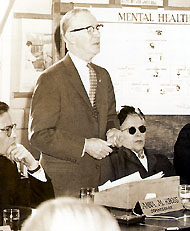
|
With Commissioner Anna M. Kross seated nearby, former Commissioner MacCormick addresses a February 1961 gathering of mental health and education professionals on Rikers. The school that began as P.S. 616 and later became P.S. 189 was dedicated in 1986 to the memory of MacCormick, generally recognized as the "Father of Correctional Education."
|
Future plans call for an expansion of the vocational training phase of the school program to include an apprenticeship type of practical trade experience.
In accordance with the Board of Education specifications, six (6) vocational shops are to be set up for the adolescent students. When the vocational shops are completed, the adolescent students will participate in a half-day vocational on the-job school training program.
Exploration will be undertaken of other types of industrial training which will make adolescent inmates more employable.
It is hoped that the remedial education classes may be expanded.
It is planned that a follow-up study will be made of the boys who have gonethrough the school.
The accomplishment of these projects depends upon the availability of funds for required new teaching positions and for expanded physical facilities.
Excerpts of Remarks by Mayor Robert F. Wagner
On Visit
to P. S. 616, Rikers Island (Wednesday, Dec. 16, 1959)
"The city-wide "600" school program was first undertaken in November 1946, by the New York City Board of Education as an experiment for the handling of grade school students in the community's regular schools who are emotionally disturbed and present disciplinary problems.
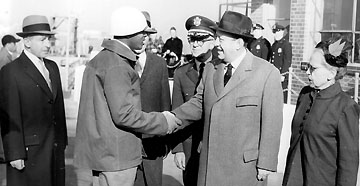
|
|
The caption in the 1959 annual report for this photo reads, "(Left to right): First Dep. Comm. Rieber; Commander of Youth Cadet Corps Honor Guard; Warden Noble (partly hidden); Maj. Gen. Raymond W. Curtis, 11 U.S. Army Corps; Mayor Robert F. Wagner; Comm. Anna M. Kross." The notation on the back of the actual photo reads: "Mayor Wagner greeted by adolescent inmate of the Military Drill Honor Guard during visit to '616' school at Rikers Island De. 16, 1959." [Photo from Correction Archives]
|
"Today it officially welcomes P. S. 616 into the fold.
There are 25 schools in the program now. The Rikers Island School is one of 9 institutional schools in the city-wide '600' school program; which also includes 11 day schools, two remand centers, and three hospital schools.
"The Rikers Island School has been in operation on an experimental basis under the Board of Education auspices since September 1959. It was opened after consultations between my office, the Board of Education and Commissioner Anna M. Kross, who arranged for the transfer of $52,610 in budgetary educational personnel funds to the Board of Education for staffing with licensed and approved teachers.
"I am indeed happy to see the educational techniques used in our community educational system now becoming an effective part of the correctional training program.
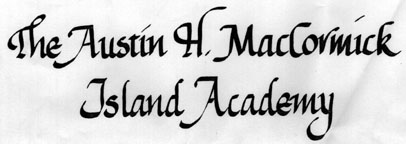
|
|
DEDICATION
CEREMONY
May 2,
1986
EDWARD
I. KOCH
Mayor
JACQUELINE MCMICKENS CommissionerDepartment of Correction
NATHAN QUINONES
Chancellor
Board of Education
AUSTIN H. MacCORMICK
1893-1979
Austin H. MacCormick, a pioneer of the Correctional Education movement
dedicated his life to the improvement of conditions in correctional facilities
and to the education of inmates. Mr. MacCormick initiated his career in
corrections in 1915 with a study of Maine's county jails and State prison. His
study included a voluntary week of incarceration in the State Prison at
Thomaston. He continued to study correctional facilities at the request of
various State, Federal and military authorities and later conducted a
nationwide study of prison education which resulted in Mr. MacCormick’s book, The
Education of Adult Prisoners: A Survey and a Program (1931), a text
that set a standard of excellence for Correctional Education practitioners and
administrators.
In 1929, at the age of 36, Mr. MacCormick was appointed Assistant Director
of the U.S. Bureau of Prisons, a position in which he was responsible for
Welfare and Education. In 1933 Mr. MacCormick was appointed by Mayor Fiorello
LaGuardia to serve as the Commissioner of Correction. During his six-year
tenure Mr. MacCormick professionalized the Department and raised it to a high
standard of honesty and efficiency. He also upgraded physical conditions and
improved vocational education opportunities for inmates. In 1940 he accepted
the position of Executive Director of the Osborne Association, Inc., a
national, private non-profit agency that is charged to improve juvenile and
adult correctional institutions and to provide post-release assistance to
ex-offenders. As Executive Director first, and President later, he continued to
enhance the Correctional Community until his death in 1979.
Mr. MacCormick received his Bachelor of Science Degree from Bowdoin College
and his Master of Arts Degree from Columbia University. He was also Professor
of Criminology at Berkeley and served on various Presidential, State and
Mayoral Task Forces concerning Corrections and Narcotic Addiction.
(The above text and graphic are from
the 1986 dedication's printed program.)
|
"As we look at these students at study and work it is most difficult to realize that they are the self-same youngsters who have been making headlines.
"Having apparently failed in the community, it is now the duty and responsibility of our correctional institutions and the community at large to re-educate and retrain them so that on discharge they may take their rightful role in the community as responsible citizens.
"Society in general has a large stake in preventing delinquency and we know that there is no one overall cure-all or known panacea for the prevention of delinquency.
"To reduce and control the problem requires the cooperative efforts of all groups engaged in the various behavioral disciplines involved in the educational, spiritual, religious, guidance and group counseling, psychiatric and psychological areas.
"In an attempt to resolve the delinquency problem our schools of higher education and learning now, too., must join and collaborate with our correctional system in order that they may carry on a continuing research program for the evaluation of the present pilot diagnostic and treatment processes in effect.
"I wish to congratulate the Youth Cadet Corps for their excellent display of marching formations and drills under the leadership of their own cadet officers.
"I am told that since this drill activity has been instituted infractions of the rules among the adolescent inmates has decreased and that it has promoted constructive discipline. This activity definitely affords an ideal opportunity for the development of good character building, conduct, and habits, with a resultant general improvement in attitudes.
"Commissioner Anna M. Kross and Superintendent John J. Theobald are to be congratulated on their making this joint cooperative educational effort a practical reality. This educational project will be watched with a great deal of interest by the entire community."
|
 The NYC Board of Education school now known as Austin MacCormick - Island Academy began on Rikers as P.S. 616 in September, 1959. DOC Commissioner Anna M. Kross hailed the event with five pages of related text and photos in her 1959 annual report (cover shown left). Among the photos was one (shown right) taken during a visit with Commissioner Kross to Rikers classrooms by former DOC Commissioner Austin MacCormick, second left, a leader in promoting inmate education. The text below is from the 1959 annual report.
The NYC Board of Education school now known as Austin MacCormick - Island Academy began on Rikers as P.S. 616 in September, 1959. DOC Commissioner Anna M. Kross hailed the event with five pages of related text and photos in her 1959 annual report (cover shown left). Among the photos was one (shown right) taken during a visit with Commissioner Kross to Rikers classrooms by former DOC Commissioner Austin MacCormick, second left, a leader in promoting inmate education. The text below is from the 1959 annual report.